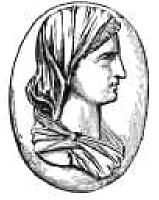According to the Muratorian Fragment, the Testamentum once included an Epistle to the Alexandrians.
Many scholars, including Moses Stuart, have suggested that this epistle was the original name for what is now known as the Epistle to the Hebrews. Alexandria, the second-largest Jewish city after Jerusalem, had a thriving early Jewish-Christian community. Additionally, a large Jewish temple existed in Leontopolis, near Alexandria, which the epistle appears to reference more accurately than the temple in Jerusalem.
Notably, the Epistle to the Hebrews is the only Pauline letter absent from the Muratorian Fragment and the only non-Pastoral letter missing from the Apostolicon.
The Authorship and Circulation of the Epistle
Clement of Alexandria believed that the Epistle to the Hebrews (or Alexandrians) was written anonymously due to Paul’s negative reputation among Jews and Jewish Christians. He also suggested that the letter was originally composed in another language and only translated into Greek later.
Like the Apostle Paul, Marcion primarily focused on converting Gentiles and had limited contact with Jewish-Christian communities where the Epistle to the Alexandrians circulated. This may explain why the epistle was not included in Marcion’s original collection.
Some scholars have proposed that Paul dictated this epistle to an amanuensis (secretary). The Epistle to the Alexandrians itself references being dictated to Tertius the Deacon while Paul was in prison. This could explain why its textual style differs from the traditionally recognized Pauline corpus.
At some point, the letter may have become a circular epistle, with its original destination either forgotten or deliberately omitted. As it was exchanged among multiple Jewish-Christian communities across the Eastern Mediterranean, it may have been renamed Epistle to the Hebrews to reflect its broader audience.
The Connection to Romans and Scribal Transmission
The opening of the Epistle to the Alexandrians was reconstructed using the 16th chapter of Romans.
Several scholars, including Richard Longenecker, have argued that Romans 16 was originally part of a separate letter that was later mistakenly appended to Romans. Interestingly, in many ancient manuscripts, Hebrews immediately follows Romans, suggesting a possible scribal error that resulted in the original opening of Hebrews being attached to the end of Romans.
The conclusion of Hebrews confirms that it was written by Paul from Rome, and Romans 16 contains greetings from various Christians in Rome—people Paul would have known only if he had already been there.
One particularly notable greeting in Romans 16 is addressed to Philologus of Sinope, the father of Marcion of Sinope and one of the Seventy Disciples of Jesus Christ:
“Salute Philologus, and Julia, Nereus, and his sister, and Olympas, and all the saints which are with them.” (Alexandrians 1:15)
Many scholars support a 14- or 15-chapter version of Romans, excluding chapter 16, aligning with the version preserved in Marcionite Christianity.
The prologue of the Epistle to the Alexandrians was reconstructed using an unused Latin prologue to Ephesians.
Marcionite Reception and Reconstruction
Although the Epistle to the Alexandrians was not originally included in Marcion’s Apostolicon, this does not necessarily mean he rejected it. It is more likely that he was simply unaware of it during his lifetime. However, later Marcionite Christians did include the epistle in an expanded canon of texts.
Marcion’s disciple Apelles appears to have continued collecting and transcribing Paul’s letters after Marcion’s death. Notably, Apelles lived in Alexandria—the very city addressed by Paul in this epistle.
For the reconstruction of the Epistle to the Alexandrians, the Marcionite Church adopted a minimalist approach, as Hebrews has long been disputed as an authentic Pauline writing. Only verses directly cited, alluded to, or attested by Clement of Alexandria (ca. 200 C.E.) were included to approximate the original, shorter form of the epistle. Other sources, including early patristic citations up to the First Council of Nicaea (325 C.E.), were also considered, particularly from biblical catenae (exegetical chains).
Exceptions were made only for:
- Verses alluded to in the Marcionite Prologue of the epistles.
- Verses necessary for textual continuity.
The reconstruction was based primarily on:
- Maegan C.M. Gilliland, The Text of the Pauline Epistles and Hebrews in Clement of Alexandria (2016).
- Philip Schaff, Ante-Nicene Fathers (1885).
Like other Pauline epistles, Hebrews was later expanded, interpolated, and edited by proto-Catholics to align with emerging church doctrine.
Inclusion in the Testamentum
Going forward, the Epistle to the Alexandrians will be included in the Testamentum within a new section called the Antilegicon. This category consists of Pauline epistles whose authenticity or value has been historically disputed.
The name Antilegicon derives from the Greek term antilegomena (“things spoken against”) fused with the book-title ending -ikon, whose κ (kappa) shifts to c in Latin, yielding -icon and thus signifying “the book of disputed writings.”
These epistles were not part of Marcion’s original Apostolicon, but the Marcionite Church views them as deuterocanonical—a second canon. The church believes that Apelles of Alexandria continued collecting and transcribing Paul’s letters after Marcion’s death.
While these texts are valuable for theological and historical study, they do not hold the same authority as the Evangelicon and Apostolicon. However, unlike apocryphal writings, they may occasionally be used for liturgical purposes.
If, in the future, these texts can be definitively confirmed as authentic works of the Apostle Paul—and if their original, non-interpolated versions are recovered or reconstructed—the Marcionite Church would consider their inclusion in the Apostolicon proper.
You can read the reconstruction of the Epistle to the Alexandrians here.



